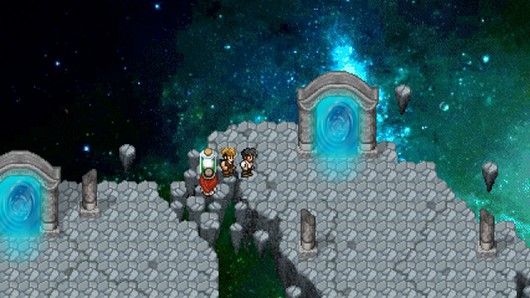Curiously-Named Game Bucks a Trend

With the benefits of time, money and experience, most video game series improve over time. Adding new game mechanics, scrapping the bad ideas and especially boosting graphics quality all keep a franchise alive. In a very strange move, one particular game, Penny Arcade: On the Rain-Slick Precipice of Darkness 3, bucks the trend. The latest in a series of episodic role-playing games based on the popular Penny Arcade webcomic, PA:ORSPD3 (No, I can’t call it anything shorter) is probably the first ever example of a series that went from cel-shaded 3-D graphics to 16-bit 1990s-SNES-style pixel art that harkens back to a time where voice-acting and third-dimensions were mere fantasy.
In my previous articles, I’ve been reluctant to review sequels. Generally the only people who are interested in sequels are those who enjoyed the earlier entries in the series; if I review sequels often, I might alienate my fanbase (Hi, Dad!). I can make an exception, however, for PA:ORSPD3, which is effectively a brand new game in its own right. For starters, it was developed by Zeboyd Games, a small indie developer that very comfortably inhabits the nostalgia-insulated niche of old-school role-playing games, and is best known for the humorous Cthulhu Saves the World. With the change in developers came not only a change in graphics, but a massive shift in gameplay. The result is that this latest entry boasts some of the slickest and most engaging gameplay in the series.
The basics of gameplay should feel familiar to any fan of role-playing games. You control a party and move through an over-world map, where most of the plot exposition and dialogue takes place. You can choose to go to different locations, all of which invariably lead to your being attacked by monsters. You fight the monsters, maybe heal yourself and sometimes attack some more in a particularly impressive fashion, probably involving bright colors and really big numbers. PA:ORSPD3 isn’t reinventing the wheel, but it does shine in several different ways. For instance, combat is deceptively complex. While it is turn-based, there is a time-meter keeping track of when exactly each character gets to act, based on their speed, the speed of the action and external factors. As such, your decisions have to take into account whether you can act before your opponent. Each of your four party members can then have up to three classes, which all have unique abilities. The number of tactical options in conjunction with the time-based combat means that any one decision can have a dramatic impact on your success, which sometimes only arises from a precise chain of different class abilities set off at just the right moment. At the same time, Zeboyd has devised several clever ways of streamlining the more monotonous aspects of role-playing games. You never have to purchase utility items such as healing potions, but rather get a finite amount with each battle. You don’t have to worry about health in-between fights, but rather start at full capacity each time. You don’t have to worry about random battles, but rather can tell when you’ll have to fight. You can save anywhere. You can run! You can fast-forward through dialogue, not that you’d want to, as humor is another one of the game’s strongest assets.
Being based on an insanely popular comedy webcomic, it’s no surprise that PA:ORSPD3 is rife with jokes hidden in every nook and cranny. The main story of the game is an exercise in epic absurdity, with the main characters, Gabe and Tycho, joining forces with a detective and a skull in a jar to kill parodic send-ups of Lovecraftian ancient gods and monsters after a powerful tome is stolen. Along the way you fight an assortment of bizarre enemies, including mimes, slimes, hobos, garbage monsters, rats, bats, knights and the like. Each enemy’s punny name and silly one-liner keeps the tone of the game light, but the real comedy comes from the dialogue between the Gabe and Tycho. Their exchanges are consistently clever and funny, and never contain too many inside jokes or references to the webcomic. You also get a real sense of who these characters are, even if the plot is nothing to write home about it.
Though I kept harping about the unusual downgrade in graphics, I actually genuine like the old-school style of the game. Admittedly, I’ve always been a fan of the charm and simplicity of pixel art, but the art in the game is also genuinely good. Each strange locale — including a haunted manor, a dilapidated pier and an otherworldly crystal bridge — is detailed and atmospheric, even with only 16 bits of color. Any fans of the old Final Fantasy games will appreciate the layout of combat, which basically copies the classic “enemies on left, party on right, box full of numbers and information below” format. In addition, the music in the game is just as fitting for the old-school style. The battle music gets you pumped, the haunted house music is cheesy and ethereal and the over-world music just sounds like adventure. An upside to the retro style is that the game runs on nearly any computer, and has even been released for Android and iOS.





Comments ()